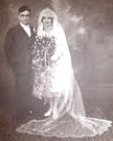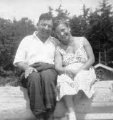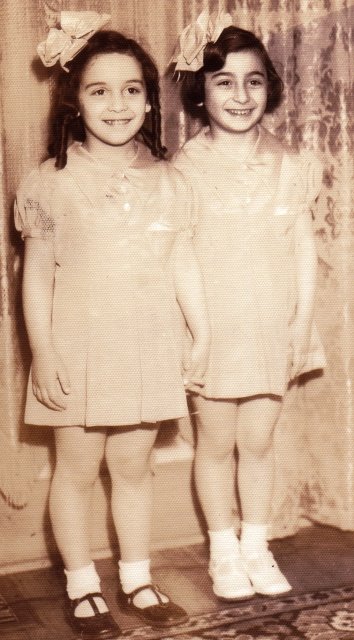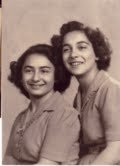The Hollywood Style
How many ways can the heritage of Greeks in America be preserved and shared? Museums? Books? Oral histories? Photographs? With access to the film industry in southern California, why not make a movie? That’s how Seattle native Zoye (formerly Joyce) Marino Fidler chose to do it. Here she is holding the two documentaries that chronicle the experience of Greeks and Greek-Americans in southern California.
It was in 1984 when Zoye volunteered to help with the summer Olympics in Los Angeles, California. When her Greek language ability was discovered, she was assigned to the visiting Greek athletes at the Santa Barbara venue. While in Santa Barbara overlooking the city she had an epiphany. Having conducted oral history interviews in Seattle, she obtained a copy of her mother’s audio recording and knew what she should do. From there, with the help of local Greek Orthodox parishes, she began conducting oral histories in Long Beach, then Northridge, Los Angeles, San Diego and other locations throughout Southern California. Since then she has conducted over 400 oral history interviews. In 1985 she was co-founder of the Greek Heritage Society of Southern California (GHS) along with Dr. James Dimitriou and Cheryl Olson. Fortunately, a number of Greeks in the film business were available and interested in helping. Now over 27 years old, the Society works in conjunction with the Basil P. Caloyeras Center for Modern Greek Studies at Loyola Marymount University. GHS has produced two documentaries, The Pioneers 1900-1940 and The Promise of Tomorrow 1940-1960. These documentaries use edited segments of the many video recordings and are scripted. Both documentaries have screened in New York City, Chicago, Illinois, Boston, Massachusetts, Delaware,Seattle, Washington, and Portland, Oregon. The Promise of Tomorrow was awarded best feature documentary at the Beverly Hills Film, TV and New Media Festival in 2010. While based in southern California, the videos tell a “universal story” of the Greek experience in America. Here is Zoye in a promotional photo with her collaborators on The Promise of Tomorrow.
Zoye’s father Marinos “Martin” Georgios Marinopoulos came from the village of Bouyiati in Arcadia in the Peloponnese region of Greece in 1907 by boat through Ellis Island. His name was changed legally to Martin George Marino. He went first to Chicago but after two months wanted to get to the Northwest because he had patriotes (friends from his village in Greece) there. He worked as a gandy dancer on the railroad to earn his way west. After a short time in Portland, Oregon, he spent unsuccessful few months searching for gold in Alaska in 1908. He returned to Seattle and worked at Bethlehem Steel. He then partnered with Chris Manthou and Elias Tountas to open the Royal Bakery in Seattle which served Safeway stores in western Washington. It was always his intention to return to Greece, but after providing dowry money for three sisters and having experienced the good life in America he decided to stay.
When Chris Manthou and his wife went to her home on the island of Leros, Greece, they visited Nicholas and Zoye Frangopoulos who had three unmarried daughters. Chris asked if any of them was willing to come to Seattle and marry a good, hardworking, religious man. One of the three, Erene, (Irene) said “I am willing.” At the age of 28 she had never left the island and wanted to see the world. She traveled from Greece, through France, and eventually to Vancouver, Canada. Martin met her there and asked, “Are you sure you want to marry me? If not, I’ll pay your way back.” Irene replied, “I didn’t come all this way not to marry you.” They met on Saturday, dated on Sunday and were married on Monday, June 17, 1929. It took six weeks to process all the papers for Irene to come to Seattle with Martin. They lived in an apartment over the Royal Bakery and Irene was able to share her life with other families from Leros: Nekou, Courounes, Cherides and Vamkros.
Zoye was born on October 17, 1930 and was followed by her sister Marian on December 31, 1931. The sisters were extremely close throughout their lives. It was a restricted life with only Greek spoken at home and friendships limited to other Greek families. Zoye felt embarrassed when she saw another Greek family involved in scouting or taking music lessons as Irene was not comfortable outside of her close Greek community. Going to Greek school, attending name day celebrations and Greek picnics provided a very comforting life, albeit a limited one for the girls. Speaking almost no English, Zoye did not recognize the name “Joyce” which the teacher had written on her chair in kindergarten. This Anglicized version was subsequently used by both Greeks and non-Greeks despite her preference for the original Greek name of Zoye. It was at Queen Anne High School that she began to branch out into non-Greek activities including talent shows, choir and girls club.
At the University of Washington she really began to have a good time with non-Greeks. Zoye studied business but was unable to finish her degree as her father had died in 1948 and she, her sister and her mother had to work to support themselves. Initially she worked at the Naval Depot near her home as a receptionist handling supplies and purchases. It was there she met her husband Jim Fidler.
About that time Zoye and a few other young Greeks from her Assumption parish organized Sigma Epsilon Phi (ΣΕΦ) in honor of their priest Stephanos Evangelos Phoutrides. They wrote a constitution and bylaws to form the organization as part of their church and to involve young veterans from World War II. This was the forerunner of GOYA (Greek Orthodox Youth of America) which was later established on a national level.
Jim Fidler had not come from a religious background. However, he found the Orthodox faith rewarding, was baptized Greek Orthodox and the family was active in their church. They had three children: William Marino Fidler, Zoye Erene Fidler now Marinopoulou, and James Anthony (Iakovos Antonios) Fidler now Marinopoulos. Young Zoye and James changed their last names as they felt a strong connection to the Greek culture. When they traveled to Greece in 1975 and met their relatives they became even prouder of their heritage. Zoye contends that not having established these connections would have been a deep loss for them.
As her children grew older, Zoye worked for a while as a secretary at her church. She was deeply involved in PTA, Brownies and scouting, activities she could not enjoy as a child. In 1975 she founded the Greek folk dance group Levendya at her church, a group that exists to this day.
At the age of 40, Zoye went to work as an administrative assistant for US Datacorp which produced microfiche and microfilm. She was able to organize its filing system and grew with the company, eventually conducting demonstrations of equipment. She became one of the top sales persons there. In 1979 when the company opened an office in California, she took advantage of the expansion and moved to its office in San Diego. Even though her children were grown, her mother was in good health and she was no longer married, it was unusual for a Greek mother to leave her home. However, because she had some Greek friends in San Diego, she was able to be part of a Greek community. After one year there, she went to work for Teledyne and then for Western Microfilm, both in Los Angeles. In 1989 Zoye found another job, this time with the Jewish Federation in Los Angeles where she shared responsibility for fund raising. Her division raised over $12 million in 1995. She retired in 1998.
In 2000 Zoye joined her friends in Seattle where she and about 50 immigrants and their descendants from the island of Leros, Greece, attended their first gathering since 1970.
In her early years Zoye occasionally resented the duality of her Greek-American life. But looking back she wouldn’t change a bit of it. Traveling to Greece, maintaining close contact with her relatives there and even obtaining dual citizenship are evidence of her feelings. Zoye says “I can’t imagine not being Greek. All four feet, 11 inches of me is Greek.”
She wishes to be remembered as having left something for future generations to help them appreciate what life has been like for Greeks in America.
By John Nicon, November 2011
PHOTOS
Zoye Marino Fidler
Zoye and friends at the CSI New York set: (l-r) John Gregory, Anna Giannotis, Zoye, Melina Kanakarides and Philip Georgious
Martin and Irene marriage, 1929
Martin and Irene, circa 1946
Marian and Zoye, circa 1938
Zoye and Marian, 1946
Sigma Epsilon Phi, circa 1950 (Zoye at lower right)
Zoye at the Jewish Federation Super Sunday: (l-r) Olivia Farzam, Michael Harris and Zoye
Zoye and Theodora Geokezas at the Lerian reunion, August 2000
Photos 1 and 9 by John Nicon; photo 2 from www.hollywood.greekreporter.com; photos 3-6 and 8 from Fidler family collection; photo 7 from The Assumption Church in History 1939-1979
SOURCES
Interview by John Nicon, October 2011; Greek Heritage Society of Southern California NEWSLETTER, Spring, 1994; The Assumption Church in History 1939-1979; www.hollywood.greekreporter.com October 7, 2011
VIDEO SEGMENTS










